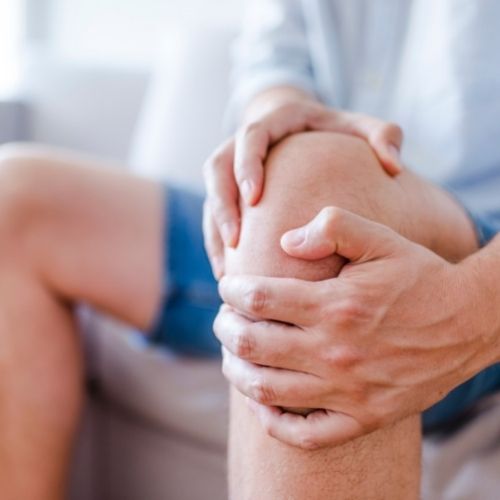In recent years, people have discovered cannabidiol (CBD), a compound found in the cannabis plant, as a popular remedy for a variety of issues. CBD is non-euphoric and evidence suggests the compound may have an anti-inflammatory effect in the body. Early research, mostly on animals, suggests that topical CBD cream may help treat inflammation, arthritis, and chronic pain.
For this reason, many people explore treating specific kinds of pain with CBD topicals, including joint pain. CBD products—not just creams, but also oils, tinctures, and gummies—have promise for people who want to help treat conditions such as anxiety, pain, and even sleep but who don’t want any mind-altering effects from tetrahydrocannabinol (THC).
CBD products are a relatively new phenomenon. Created by extracting cannabinoids from the hemp plant, these phytochemicals can then be blended into products directly or after they are purified or diluted. Since December 2018, hemp has been off the federal list of controlled substances in the US, and this has finally opened up research into the benefits of CBD for joint pain and other more specific questions.
Is CBD legal? Under some state laws, even hemp-derived CBD products with less than 0.3% THC are illegal, even though those products are legal at the federal level. Meanwhile, at the federal level marijuana-derived CBD products are illegal, even if they are legal in many states. The “marijuana-derived” distinction refers to the 0.3% THC threshold. Remember, especially if you’re going on a trip, check local laws first. And remember, nonprescription CBD products may be inaccurately labeled because the Food and Drug Administration (FDA) has not approved them.
So, Is CBD Good for Joint Pain?

When it comes to treating joint pain in particular, especially caused by problems like rheumatoid arthritis inflammation, early evidence on CBD is promising. Of course, further high-quality human studies would offer much stronger support.
Research from 2020 found that CBD has anti-arthritic benefits and may improve symptoms by targeting cells that drive inflammation. A 2017 animal model of osteoarthritis reveals that CBD improves markers of pain, inflammation, and nerve damage.
A rat model of arthritis in a 2015 study indicates that CBD may reduce arthritic inflammation and pain. And according to a pharmacologic review, most people tolerate cannabinoids such as CBD well, and these compounds show promise in the management of chronic pain.
Anecdotal evidence in the form of a recent Arthritis Foundation poll suggests that CBD may help with markers of joint pain. 94% of the respondents who were CBD users treated pain with CBD, while 67% of participants said CBD improved their overall physical functioning.
Considering that even low dose opioids and other more traditional methods for pain management are so risky, its easy to see why CBD pain management is appealing for patients with various types of arthritis and other chronic pain.
What Is CBD Cream?
There are various chemical compounds in the cannabis plant in nature. One of these causes the psychoactive “high” that the plant is well-known for: tetrahydrocannabinol (THC).
However, other important cannabinoids do not induce this feeling. The best-known of these to date is cannabidiol (CBD). Numerous proponents and a growing number of researchers say that CBD offers many health benefits.
The Food and Drug Administration (FDA) approved just one drug based on CBD: Epidiolex. This treats some kinds of seizures. However, to date, no CBD cream has gained FDA approval for any treatment goal, including joint pain.
CBD topicals and creams blend CBD extract with some mixture of fats, butters, and oils. Alongside these rich ingredients manufacturers often include other topical pain-relieving ingredients, such as capsaicin, menthol, arnica, or camphor.
CBD labels can be confusing to a cannabis veteran, let alone a first-time shopper. This is a CBD glossary of some common terms on the labels of CBD topicals for joint pain:
- Cannabis: The Cannabis sativa plant includes both marijuana and hemp plants and produces all of the cannabinoids, including THC and CBD.
- Cannabinoids: Naturally occurring cannabis plant compounds that produce a number of health benefits. THC and CBD are only two of the cannabinoids among possibly hundreds, including CBC, CBG, CBN, and others.
- THC: The psychoactive cannabinoid that produces cannabis’s euphoric and sometimes sedating effects.
- Terpenes: Organic compounds which create the taste and aroma of cannabis.
- The endocannabinoid system (ECS): The ECS is a widespread neuromodulatory system with receptors throughout the mammalian body, including the skin, that moderates the development of the central nervous system (CNS), immune response, and synaptic plasticity.
- CBD isolate: This extract is highly purified and contains just pure CBD.
- Broad-spectrum CBD: This type of CBD product removes THC but retains all other cannabinoids.
- Full-spectrum CBD: Full-spectrum CBD products retain the complete cannabinoid and terpene profile of the source cannabis plant, including the THC.
Does CBD Cream Help with Joint Pain?
Arthritis is the most common cause of joint pain. According to the Arthritis Foundation, there is promising but inconclusive research on CBD for arthritis.
To begin with, most current research on CBD suggests it helps reduce the inflammation that triggers arthritis pain, and that being a numbing or pain relief agent is not its primary benefit. In other words, it is less likely to produce immediate results for acute pain and noticeable results may require long-term use—with an exception being CBD topicals with ingredients known to treat acute pain.
An older but still reputable study from 2000 of arthritis in mice found that oral CBD targeted inflammatory chemicals to reduce arthritis symptoms—but it did not study CBD cream. A 2015 study on arthritis in rats found that 4 consecutive days of treatment with CBD cream produced fewer inflammation markers and pain-related behaviors.
Although some research studies CBD in humans, none of that focuses on CBD creams. A preliminary assessment of Sativex found that it could reduce arthritis pain with regular use over 5 weeks, but again, this does not address a CBD cream. In addition, similar research studies CBD use alongside other cannabis derivatives, so it can be difficult to determine which derivatives should get the credit for any apparent benefits.
How to Shop For CBD Topicals
No government agency regulates the potency, safety, or effectiveness of CBD products. This means you’re relying on CBD brands to be transparent and open about their extraction processes and other practices. Find the best CBD products by learning how to read their labels effectively. The amount of CBD in each dose is really just the beginning.
Ingredients
Always be a label-reader when you’re shopping for the best CBD oils and creams. Remember, look for a product that contains hemp extract, because CBD isn’t found in hemp seeds. If the label only lists Cannabis sativa oil, hemp seeds, or hempseed oil as active ingredients, it’s not a CBD product.
Flavored oils, tinctures, and CBD gummies usually have added sweeteners and extracts most don’t enhance effects, although they increase product palatability. For joint pain, look for ingredients such as arnica, camphor, or turmeric that are proven to help reduce inflammation and pain.
Carrier oils like olive oil and MCT oil (a kind of coconut oil) make it easier to consume CBD extracts. They rarely have benefits or excessive flavor of their own.
CBD source
Look for US-grown hemp that is regulated by agricultural standards. Aim for family-owned businesses, a non-GMO designation for companion ingredients, or organic hemp farms depending on your goals. In the United States, Colorado and Kentucky are among the strongest states for hemp, even for CBD creams.
Test results
Reputable CBD companies with high-quality products provide results from third-party lab testing and post a certificate of analysis (COA) on the company’s website or product’s page. Verify the cannabinoid profile on the COA, including stated potency, and ensure the product is free of contaminants such as pesticides, mold, and heavy metals.
CBD Safety, Side Effects, and Risks
CBD is considered to be safe as ongoing results show few complications or side effects. At the right dosage, most people tolerate CBD well.
However, possible CBD side effects include lightheadedness, drowsiness, digestive upset, diarrhea, changes in weight, and changes in appetite. More significant side effects can occur in people who are sensitive to CBD or who take more than they need.
It’s important to know that drug interactions with CBD are possible. A 2019 study found that internally consumed CBD may interact with a number of drugs, but that study did not deal with CBD topicals. Even so, always speak to a doctor before taking CBD to check for any interactions.
People should also be aware that the federal government does not regulate CBD or any other natural products. This means when it comes to label accuracy, dosing, or potential contamination, there are no set standards in place.
How to Use CBD Products for Joint Pain
What kind of CBD product people like for pain management varies because the right delivery method is largely a matter of personal preference.
CBD you take orally, such as CBD drops, CBD tincture, CBD gummies, or CBD spray, has to get through the digestive system to enter the bloodstream and interact with the body’s cannabinoid receptors, but then lasts for several hours and provides all-over relief. This type of CBD product also affects the whole body with long-term effects while allowing for precise doses, with each edible marked with precisely how many mg of CBD it contains.
And for some forms of pain or issues like nausea, a CBD vape is often the best choice—because it delivers the same whole-body effects as an oral product, but quickly.
However, since joint pain from conditions like arthritis may be isolated to several joints or problem areas, a topical CBD lotion or balm is often a better solution. Topical CBD, such as CBD cream, passes right into the skin as you massage it into the joints. It’s much tougher to determine dosage since the CBD and other ingredients need to penetrate the skin barrier to work. To get the right dose for your pain, it may be necessary to use the product a few times, changing the dose until you hit the sweet spot.
Always start with the label, though, and follow the instructions as each product is unique. Wait several hours before taking additional doses so you understand how the CBD topical affects you.
Natural Remedies for Joint Pain
There are a number of natural, over-the-counter products that can help with pain and markers of inflammation in some people with joint pain from arthritis, such as Boswellia, cat’s claw, capsaicin, ginger, and turmeric. Some CBD products include extra topical ingredients as well, as discussed above. Other natural supplements for joint pain include omega-3 fatty acids, gamma-linoleic acid, glucosamine and chondroitin, probiotics, and thunder god vine.
FAQs about CBD products
What CBD treatment option should I use for joint pain?
Personal choice is the most important factor in the type of CBD and the type of CBD product you like. For relief of pain in a specific joint or area, a topical CBD lotion or salve may be ideal. Products like CBD oils or gummies may be better for all-over, long-term relief.
Should a CBD product for joint pain contain THC?
This is a personal call. Look for a label that reads THC-free or broad-spectrum, or lists CBD isolate, if you want to avoid THC completely.
If you’d added prefer the benefit of the entourage effect, which allows all of the cannabis plant’s natural cannabinoids and terpenes to interact with the receptors of the body’s endocannabinoid system (ECS), and you don’t mind taking THC, a full-spectrum product is better.
There is some evidence that the ongoing entourage effect helps balance the ECS, bringing stasis to the immune system and producing other overall wellness benefits. Even “full-spectrum CBD oil” will, under federal law, contain less than 0.3% THC.

CBD has so much promise when it comes to treating joint pain. Proof will demand more high-quality research from human studies and not just animal studies, but anecdotally, many CBD users relieve joint pain with topicals.
Remember: take CBD products as directed, choose products with third-party testing and COAs, check labels carefully, and seek medical advice before treating joint pain with CBD.


